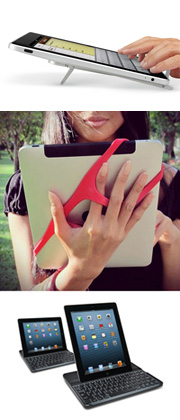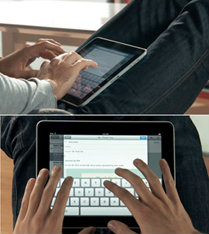 Mobile working offers you freedom from the office and increased flexibility to work from anywhere. Sometimes this means you may end up working in spaces and places that weren’t designed with comfort in mind not to mention ergonomics.
Mobile working offers you freedom from the office and increased flexibility to work from anywhere. Sometimes this means you may end up working in spaces and places that weren’t designed with comfort in mind not to mention ergonomics.
The use of iPads and other touch screen devices provides even easier access to the office and their use has become pervasive in businesses. The rate of tablet ownership is expected to continue to grow. Recently a client advised me that they had approved iPads for their employees to use when traveling or working outside of the office which led me to thinking… Is this increased usage giving us back pain or creating other ergonomic challenges?
“...love of our new mobile devices promotes poor postures...”
Yes, according to a study out of Harvard. Researchers found this love of our new mobile devices promotes poor postures which strain the upper back, neck and shoulders. All of the ergonomic evils of the laptop are present in these popular devices: Stressful non-neutral neck postures while looking down at the screen, repetitive forward reaching of the shoulder (shoulder flexion) when touching the screen, and a rotated forearm (pronation). We have some real concerns with the ergonomic implications of these touch screen devices when used for more than a short period of time.
“The beauty of tablets and other mobile devices is their flexibility,” says Dr. Jack Dennerlein, director of the Occupational Biomechanics and Ergonomic Laboratory at HSPH (Harvard School of Public Health). “You can use them almost anywhere and in different ways. You can hold them in your lap, you can hold them in your hand. The problem is that some of the postures people are in when using a tablet can be awkward and lead to discomfort with prolonged use.”
Research conducted by Dr. Dennerlein and his colleagues at the HSPH studied four ways that people use tablets: Lap-Hand (tablet held on the lap); Lap-Case (resting the tablet in its case at an angle on your lap); Table-Case (tablet placed on table in a case angled at a low angle); and Table-Movie (resting the tablet at a steep angle on a table).
 The worst way to use your iPad is on your lap which forces the neck to bend forward too much, straining and possibly even injuring muscles, nerves, tendons, ligaments, or spinal discs. Their research showed that simply placing a tablet on a table propped at a higher angle in a tablet case or support (Table-Movie position) can reduce neck strain and potential pain. These cases reduce the need to grip the device, and also allow it to be propped up at an angle that keeps the user’s head in a neutral position, minimizing neck strain. And second, give your neck a break. "Usually we tell people they should change their position every 15 minutes," says Dr. Dennerlein. "Just change your hands, shift your weight. Stand up or sit down."
The worst way to use your iPad is on your lap which forces the neck to bend forward too much, straining and possibly even injuring muscles, nerves, tendons, ligaments, or spinal discs. Their research showed that simply placing a tablet on a table propped at a higher angle in a tablet case or support (Table-Movie position) can reduce neck strain and potential pain. These cases reduce the need to grip the device, and also allow it to be propped up at an angle that keeps the user’s head in a neutral position, minimizing neck strain. And second, give your neck a break. "Usually we tell people they should change their position every 15 minutes," says Dr. Dennerlein. "Just change your hands, shift your weight. Stand up or sit down."
So, keeping your head in a neutral position may make all the difference in minimizing “iPad” neck strain!
Keep in mind that tablet use also increases the user’s wrist extension when holding the tablet for long periods or when keying. Gripping an iPad can be forceful in terms of the forearm muscles so if you do need to hold it for extended timeframes alternate left and right hands to avoid static wrist flexion. Using a grip strap may minimize awkward wrist postures, and avoid a pinch grip when holding the tablet. It may also prevent an iPad from slipping out of your hands.
The iPad’s compact design with an integrated screen and keyboard forces you to choose between good hand and wrist posture versus good neck posture. Your best posture depends on how you’re using the tablet.
If you’re simply viewing the screen without needing to touch it, then elevate the screen and angle it in an upright position. Touchscreen typing is another story! Typing on an iPad keyboard for more than a few paragraphs can be frustrating (at least I found it so). Touchscreen typing is not ergonomically sound and is even more difficult when typing while standing up or holding the iPad with one hand.
In addition, the screen has a different “touch” than a regular keyboard. For intensive inputting (keying), consider using an external keyboard that links with Bluetooth connections. Sit in a comfortable position with your shoulders relaxed and elbows close to your body. Keep your hands, wrists and forearms in a neutral position.
If you choose to use an iPad or tablet, remember these were not designed to replace your laptop computer but rather for shorter, quick interactions. The lightweight and compact design along with its direct access makes it easy to carry and stay connected. I love the convenience of my iPad and keep finding new ways to increase my productivity. Keep it short, keep it safe and enjoy your iPad.







 Follow these tips when you are using an iPad or tablet to prevent neck and eye strain:
Follow these tips when you are using an iPad or tablet to prevent neck and eye strain: Mobile working offers you freedom from the office and increased flexibility to work from anywhere. Sometimes this means you may end up working in spaces and places that weren’t designed with comfort in mind not to mention ergonomics.
Mobile working offers you freedom from the office and increased flexibility to work from anywhere. Sometimes this means you may end up working in spaces and places that weren’t designed with comfort in mind not to mention ergonomics. The worst way to use your iPad is on your lap which forces the neck to bend forward too much, straining and possibly even injuring muscles, nerves, tendons, ligaments, or spinal discs. Their research showed that simply placing a tablet on a table propped at a higher angle in a tablet case or support (Table-Movie position) can reduce neck strain and potential pain. These cases reduce the need to grip the device, and also allow it to be propped up at an angle that keeps the user’s head in a neutral position, minimizing neck strain. And second, give your neck a break. "Usually we tell people they should change their position every 15 minutes," says Dr. Dennerlein. "Just change your hands, shift your weight. Stand up or sit down."
The worst way to use your iPad is on your lap which forces the neck to bend forward too much, straining and possibly even injuring muscles, nerves, tendons, ligaments, or spinal discs. Their research showed that simply placing a tablet on a table propped at a higher angle in a tablet case or support (Table-Movie position) can reduce neck strain and potential pain. These cases reduce the need to grip the device, and also allow it to be propped up at an angle that keeps the user’s head in a neutral position, minimizing neck strain. And second, give your neck a break. "Usually we tell people they should change their position every 15 minutes," says Dr. Dennerlein. "Just change your hands, shift your weight. Stand up or sit down." Most new computers come with a standard keyboard and mouse. For many people, these may work fine for a while. But remember - the selection of a good ergonomic mouse can make a significant difference in mousing comfort during everyday computing.
Most new computers come with a standard keyboard and mouse. For many people, these may work fine for a while. But remember - the selection of a good ergonomic mouse can make a significant difference in mousing comfort during everyday computing. It’s ironic that the convenience of laptop computers – the compact design that makes them ideal for on-the-go users – also makes them ergonomically undesirable. Condensed keyboards lead to awkward hand positions; small attached screens lead to neck and eye strain, and built-in touchpads promote repetitive stress injuries. It’s a dilemma: convenience or comfort; portability or pain… aside from givi...
It’s ironic that the convenience of laptop computers – the compact design that makes them ideal for on-the-go users – also makes them ergonomically undesirable. Condensed keyboards lead to awkward hand positions; small attached screens lead to neck and eye strain, and built-in touchpads promote repetitive stress injuries. It’s a dilemma: convenience or comfort; portability or pain… aside from givi...
 Payments securely processed by:
Payments securely processed by: 